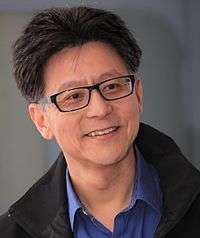Chao Tang
| Chao Tang | |
|---|---|
 | |
| Alma mater |
University of Science and Technology of China University of Chicago (PhD) |
| Known for |
Self-organized criticality Bak–Tang–Wiesenfeld sandpile |
| Scientific career | |
| Fields | Physics, Biology |
| Institutions | Peking University |
| Doctoral advisor | Leo Kadanoff |
Chao Tang (汤超) is a Chair Professor of Physics and Systems Biology at Peking University. He had his undergraduate training at the University of Science and Technology of China, and received a Ph.D. degree in Physics from the University of Chicago. In his early career, he worked on problems in statistical physics, dynamical system and complex systems. In 1987, along with Per Bak and Kurt Wiesenfeld, he proposed a concept and developed a theory for self organization in certain complex systems, which they coined self-organized criticality. The model they used to illustrate the idea is referred to as the Bak-Tang-Wiesenfeld "sandpile" model. His current research interest is at the interface between physics and biology. Specifically, he focuses on systems biology and works on problems such as protein folding, cell cycle regulation, function-topology relationship in biological network and cell fate determination. He was a Professor at the University of California San Francisco before returning to China full-time in 2011. He is a Fellow of the American Physical Society, the founding director of the interdisciplinary Center for Quantitative Biology at Peking University and the founding Co-Editor-in-Chief of the journal Quantitative Biology.
Selected publications
- Self-organized criticality[1][2]
- Protein folding[3]
- Robustness in cell cycle control[4]
- Network topology, function and dynamics[5]
- Cell fate determination[6]
References
- ↑ Bak, P., Tang, C. and Wiesenfeld, K. (1987). "Self-organized criticality: an explanation of 1/f noise". Physical Review Letters. 59 (4): 381&ndash, 384. Bibcode:1987PhRvL..59..381B. doi:10.1103/PhysRevLett.59.381.
- ↑ Bak, P., Tang, C. and Wiesenfeld, K. (1988). "Self-organized criticality". Physical Review A. 38 (1): 364&ndash, 374. Bibcode:1988PhRvA..38..364B. doi:10.1103/PhysRevA.38.364.
- ↑ Li, H., Helling, R., Tang, C. and Wingreen, N. (1996). "Emergence of Preferred Structures in a Simple Model of Protein Folding". Science. 273 (5275): 666&ndash, 669. arXiv:cond-mat/9603016. Bibcode:1996Sci...273..666L. doi:10.1126/science.273.5275.666.
- ↑ Li, F., Long, T., Lu, Y., Ouyang, Q. and Tang, C. (2004). "The yeast cell-cycle network is robustly designed". Proceedings of the National Academy of Sciences. 101 (14): 4781&ndash, 4786. arXiv:q-bio/0310010. Bibcode:2004PNAS..101.4781L. doi:10.1073/pnas.0305937101.
- ↑ Ma, W., Trusina, A., El-Samad, H. Lim, W. and Tang, C. (2009). "Defining Network Topologies that Can Achieve Biochemical Adaptation". Cell. 138 (4): 760&ndash, 773. doi:10.1016/j.cell.2009.06.013. PMC 3068210. PMID 19703401.
- ↑ Shu, J.; et al. (2013). "Induction of Pluripotency in Mouse Somatic Cells with Lineage Specifiers". Cell. 153 (5): 963&ndash, 975. doi:10.1016/j.cell.2013.05.001.